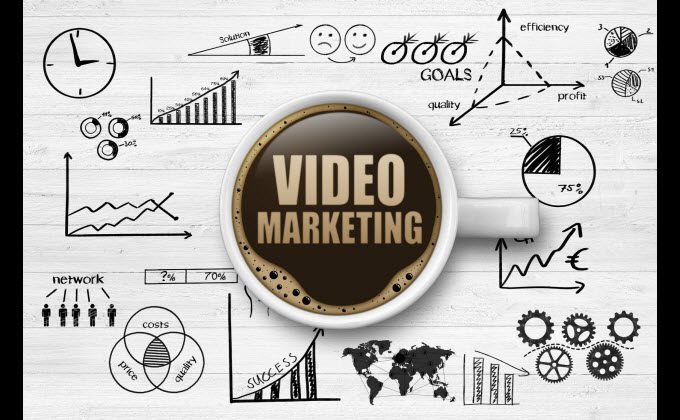
Why you need a video strategy before you need an actual video
Brands need a video marketing strategy — this idea isn’t new. What has changed is how important video has become on every platform and channel.
It’s no longer just one piece of your overall marketing plan. It’s central to your outreach and campaign efforts … especially your social strategy.
Why is this important? Well, if you aren’t creating video, you’re likely falling behind.
Why You Need to Focus on Video Marketing in 2019
2016 saw a surge in the popularity of video as a content marketing format. 2017 saw video rise to the top of your marketing tactic list. What did 2018 see? In short, 2018 transformed video from a singular marketing tactic to an entire business strategy.
Video as a tactic was likely developed by you or your creative team as an one-to-many awareness play and little analysis to show for it.
Video as a strategy is quite the opposite. It should be produced by all teams, in a conversational, actionable, and measurable way. Video as a strategy is the future.
According to a report from HubSpot Research, more than 50% of consumers want to see videos from brands … more than any other type of content.
Video hasn’t only transformed how businesses market and consumers shop; it’s also revolutionized how salespeople connect with and convert prospects and how service teams support and delight customers. In short, video is incredibly useful throughout the entire flywheel — not just to heighten brand awareness.
The 9 Types of Marketing Videos
Before you begin filming, you first need to determine the type of video(s) you want to create. Check out this list to see your options.
1. Demo Videos
2. Brand Videos
3. Event Videos
4. Expert Interviews
5. Educational or How-To Videos
6. Explainer Videos
7. Animated Videos
8. Customer Testimonial Videos
9. Live Videos
The Video Creation Process
Before you set up, record, or edit anything, start with a deep conversation about the purpose of your video. Why? Every decision made during the video creation process will point back to your video’s purpose and what action you’d like your audience to complete after watching it.
And, of course, without a clear purpose agreed upon by your team, you’ll find yourself in a whirlwind of re-shooting, re-framing, editing and wasting a lot of precious time.
What Should I Ask Myself?
- Who’s your target audience? What buyer persona are you targeting? This may be a segment of your company’s typical buyer persona.
- What’s the goal? Is it to increase brand awareness? Sell more event tickets? Launch a new product? Ultimately, what do you want your audience to do after watching the video?
- Where’s the video going to live? On Facebook? Behind a landing page form? You should begin with one target location — where you know your audience will discover the video — before repurposing it for other channels.
- When’s it due? Always start with a timeline. A video on which you have a few months to work will have very a different budget and creative scope than a video needed in a few days.
- What’s the budget? Video can be expensive, but it doesn’t have to be … if you set a budget. Do your research and set realistic parameters, especially before you answer the next question. Many marketers make the mistake of thinking that putting a ton of money into a video project will automatically make it a huge success. On the flip side, not spending enough on a far-reaching campaign could hurt your brand’s image by not letting the messaging come across in a low-quality way. When it comes to actually making the video content, keep your campaign goals in mind and make sure you’re spending your budget well.
- What are the creative requirements? With your budget, skills, and resources in mind, think about the creative roadblocks that might arise. Do you need a designer to create lower third graphics? Are you going to create an animated video or a live action video?
- What will constitute success for the video? Choose several key performance indicators that correspond with your video goals — or hop down to the chapter in this guide on measuring and analyzing video.
How to Use Video Throughout the Flywheel
Too often, companies jump at the opportunity to create their first video. They spend tons of money on an explainer video for their homepage, but as soon as the project is complete, all future video ambitions screech to a halt.
On the other hand, plenty of businesses churn out a slew of social videos. But since they’ve simply replicated fads they’ve seen, their videos hardly consider their audience’s challenges or habits.
Considering the time, money, and resources involved, video marketing can’t be an impulsive guessing game. Instead, you need to create a comprehensive video marketing strategy that applies to every facet of your flywheel. This means thinking in the context of the inbound methodology.
The inbound methodology is the marketing and sales approach focused on attracting customers through content and interactions that are relevant and helpful. Each video you create should acknowledge your audience’s challenges and provide a solution. Looking at the big picture, this content guides consumers through the journey of becoming aware of, evaluating, and purchasing your product or service.
To start, plan to create at least two videos for each. Don’t forget to include call-to-actions to help lead your audience through their purchase journey and into the role of “promoter.” Over time, you can improve based on conversion rates and the content gaps you discover.

Attract (Marketing)
The first step of the inbound methodology is to attract — or turn strangers into visitors. Consumers at this stage are identifying their challenges and deciding whether or not they should seek out a solution. Therefore, the videos you create should empathize with their problems and introduce a possible solution in your product or service.
Ultimately, the goal of this kind of video video is to expand reach and build trust. Because you are looking to garner shares for your video, it’ll likely be more entertaining and emotion-evoking than educational. But, you should should still provide enough information to associate yourself as an authority on the topic.
Convert (Marketing + Sales)
Now that you’ve attracted video viewers and website visitors, the next step is to convert these visitors into leads. With most inbound marketing content, this means collecting some sort of contact information via a form. Video can aid this process by visualizing a solution to the buyer’s problem, whether that’s before the form on a landing page or as the offer itself. Overall, the goal of this kind of video is to educate and excite.
“Convert” videos may include a webinar filled with tactical advice, product demos sent via email, landing page promotional videos, case studies, or more in-depth explainer and how-to videos. For example, while an “attract” video might provide a quick tip for nailing a sales pitch, a “convert” video could be an animated explainer video that breaks down the inbound sales methodology.
Close (Sales)
You’ve attracted a new audience with your videos and converted the right visitors into leads. Now’s the time to close these leads into customers. Yet, as important as this stage is, “close” videos are often the most overlooked by marketers and salespeople.
At this point, the consumer is weighing their options and deciding on the purchase. Therefore, the goal of this kind of video is to make your audience visualize themselves using your product or service — and thriving. There’s a reason 4X as many customers would rather watch a video about a product than read about it. Videos are able to display functionality and leverage emotions in ways a product description never could.
Great “close” videos include testimonials of customers with relatable stories, in-depth product demos, culture videos that sell viewers on your quality of service, or even personalized videos that explain exactly how your product could help their business
Delight (Service)
A purchase may have been made, but there’s still a lot video can do to leverage the post-conversion stage of your flywheel. During the “delight stage” of the inbound methodology, your goal is to continue providing remarkable content to users that makes their interaction with your product or service as incredible as possible. It’s also in hopes that they’ll tell their connections about their experience or up-sell themselves. Therefore, the goal of this type of video is encourage your customers to embrace your brand and become brand evangelists…..a cheering section if you will.
Your first opportunity to delight comes directly after the purchase. Consider sending a thank you video to welcome them into the community or an onboarding video to get them rolling with their new purchase. Then, build out a library of educational courses or product training videos to cater to consumers who prefer self-service or simply want to expand their expertise.
Defining Your Goals and Analyzing Results
At this point, you know how to create a video and where to host it. You’re ready to get started, right? Not quite. Before you dive in, you need to define your video goals and identify the best metrics for determining whether you’ve accomplished those goals.
Before launching any marketing campaign, it’s important to determine your primary video goal. This could be to increase brand awareness, engagement, or even conversions for a free trial. It’s crucial to pick out just one or two goals for each video. When you define more than that, your video will seem unfocused, making it difficult for viewers to determine what they should do next.
When thinking of your goals, be sure to keep your buyer persona and target audience in mind. How old are they? Where do they live? What are their interests? How do they typically consume media? What stage of the buyer’s journey are they in?
All of these questions can help determine what type of video you should make and where you should post it. For example, if your target audience is not familiar with your company, you probably want to make a video that focuses on brand awareness before producing an in-depth, product video. You’ll also want to host your video on a site that already has a large reach, like YouTube.
Conclusion
Developing a successful video marketing strategy takes time, but by trying out different video formats and testing their performance as you go, you’ll be on your way to making the most of this innovative medium and finding a space for yourself in the lucrative video marketing industry that’s just around the corner.
Your audience craves video. Your business needs video. We’re here to make that decision easier for you. Give us a call, 678-744-3908



